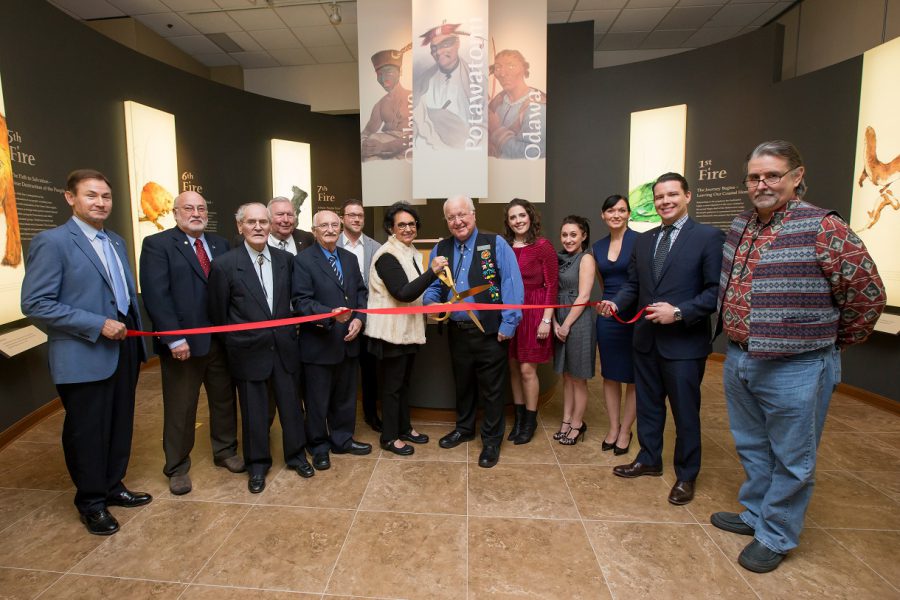
The Citizen Potawatomi Nation Cultural Heritage Center’s completed remodel recently opened to visitors for the first time since March 31, 2014.
“We’re reopening this center for the heritage of our people,” said CPN Cultural Heritage Center Director Kelli Mosteller “These renovations and upgrades will allow us to continue to educate our community about the Potawatomi Nation’s culture, heritage and history. It will be the start of a new era for the center and our people.”
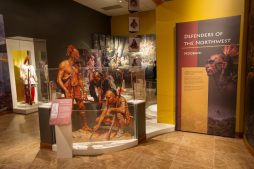
New, updated and digital interactive exhibits tell a more complete narrative, beginning with Citizen Potawatomi oral traditions, through early ways of life, conflict and forced removals before examining more recent history, including U.S. and Oklahoma history, and ending with the Citizen Potawatomi Nation as it is today.
The Jan. 20 reopening marked the first time the Tribe’s fully utilized technology to help tell some of these stories, Mosteller said.
For many, the reopening signifies the strength and determination of CPN to continue its mission of educating tribal members, the greater Native American community and other visitors about the historical and contemporary aspects of the Potawatomi Nation.
“We took this opportunity to renew the exhibit and more thoroughly tell the tale of the Citizen Potawatomi Nation,” said Tribal Chairman John “Rocky” Barrett. “This wouldn’t be possible without the tireless effort and incredible amount of talent exhibited by the heritage center staff and everyone else that contributed. I am extremely proud of what they have accomplished.”
More than a museum
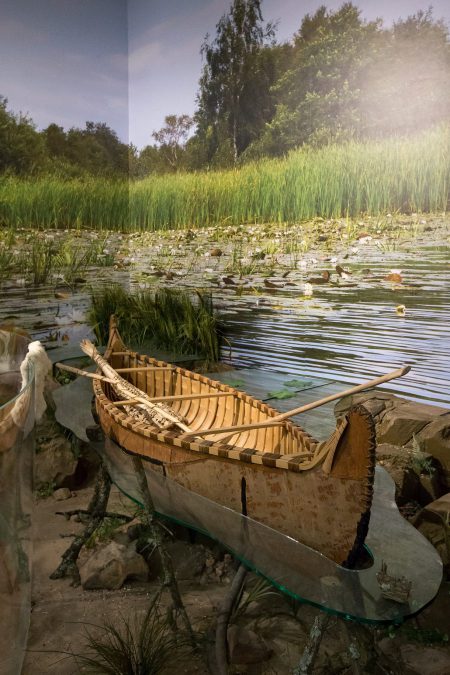
The center leads visitors on a journey through Potawatomi, Oklahoma and U.S. history, beginning with pre-European contact and continuing to present day. Digital displays and interactives feature an astrology exhibit, a life-sized replica of a handmade Potawatomi canoe and a wigwam, a traditional Potawatomi style home.
“There is a difference between a museum and a cultural heritage center,” Mosteller said. “We are a museum in the sense that we are here to protect, preserve and display our cultural artifacts for the public and for tribal members, but we are a cultural heritage center because of everything else that goes along with it. We are here to not only preserve the objects themselves but the histories, stories and family lineage behind these objects.”
The Cultural Heritage Center is also a place for tribal members to learn by participating in cultural activities and the Potawatomi language. The Mezodan Research Library offers more than more than 7,000 mixed-media resources, giving tribal members access to one of the most diverse collections of Eastern Woodland American Indian ethnology, language and ethnohistory in both the region and among tribal libraries nationwide.
“Our tribal leaders are extremely proud of the special exhibits that the heritage center brings to our tribal community and to area residents,” said CPN Vice-Chairman Linda Capps. “The quality of the displays is an attraction to people statewide. While the exclusive displays at the center highlight Potawatomi heritage, they are a tribute to other tribes as well. The concept of forced relocation, loss of lands and the economic necessity of moving common to many tribes is depicted in the displays at the center.”
Team effort
Washington museum design firm Atlas Fine Art Services helped create the overall look and feel of the new exhibits. The firm has helped with exhibits for other Oklahoma tribes. Atlas and a handful of other vendors were among the small number of those outside the tribe to contribute to the project.
“This wouldn’t be a true cultural heritage center if tribal members didn’t have a hand in creating it,” Mosteller said.
Employees from tribal departments, ranging from construction to information technology and public information, all helped with the renovation. For example, FireLake Designs printed and cut artwork and text for images on various walls and objects with the help and direction of CHC staff.
“Imagery is a critical piece in the new exhibits because we wanted to take photographs we have of tribal members to incorporate people who were actually members of the tribe,” Mosteller said. “Having someone on-site at the nation who can understand our vision has been important. Without having FireLake Designs here, this would be a much more complicated process, and I don’t know if a lot of things we are doing mural-wise would have been possible.”
The information technology department helped install the technology used for the exhibits and create interactive games and maps.
“Younger generations are used to learning with technology,” Mosteller said. “To go into a museum and have that stripped away can be jarring; they can lose interest. We wanted to make use of technology to tell our story fully.”
Some of the interactives allow visitors to explore maps of former reservations and allotment lands, while others engage visitors via touch-screen games. There are traditional Potawatomi games like the moccasin game, bowl and dice and snow snake.
Others provide visitors a better understanding of complex scenarios that played out between the Potawatomi and United States government. One such interactive is Choose Your Path, a touch-screen interactive game in which guests are presented with a scenario and asked to make a choice; those choices ultimately lead to consequences actual tribal leaders faced before being forcibly removed from their ancestral homelands.
“I think these interactives are a fun way to experience more of the culture and for visitors to gain a better understanding. … I also really like that there are items in the exhibits you can touch and interact with,” said CPN software developer Nathan Hawkins, who was responsible for the programming for each of the interactives. “The Choose Your Path interactive gives them a chance to walk in the shoes of their ancestors and feel how difficult the decisions were to make.”
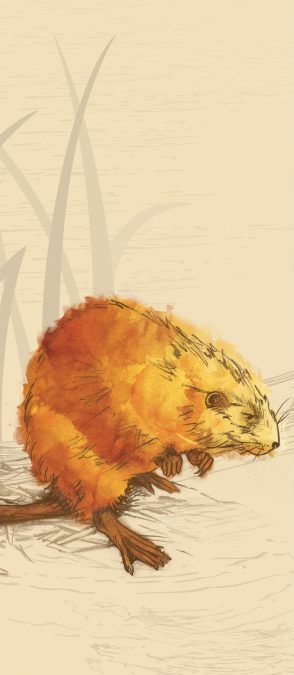
CPN’s public information department also contributed to writing and designing exhibit panels. Graphic designer and tribal member Trey DeLonais helped create many panels, images and murals throughout the Cultural Heritage Center.
“Every section of this renovation has required me to step outside my comfort zone and learn something new,” DeLonais said. “It started with the water coloring on the animals in section one, and it ended with stitching multiple images together to create the massive murals on the walls in section four. Being part of this renovation has been very challenging, but more so rewarding.”
Aviary staff Jennifer Randell and Bree Dunham helped draw the animals in section one. A turtle, otter, snake, bear, muskrat, eagle and pike represent the Seven Fires prophecy. They were carefully researched and drawn to represent each animal as it would have been known to Potawatomi in the Great Lakes region.
“We enjoyed being a part of developing the animals for this exhibit,” Randell said. “My favorite is the muskrat, but I enjoyed working on all of them. It’s an honor to help create something that represents such an important part of our culture and history.”
Exhibits and more
The center’s combination of traditional, digital and interactive arrangements are now more immersive and tell a deeper, more accurate story of Potawatomi history.
“We wanted to make sure that visitors of all ages would be engaged in the exhibits, so we’ve added a lot of different interactives and videos,” Mosteller said. “Not every person who walks through the door will be interested in every aspect of the museum, but we really tried to deliver exhibits that had something for everyone.”
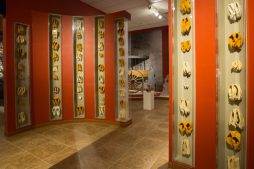
One key exhibit is a wall of moccasins featuring 86 pairs of soft leather footwear that were handmade by tribal members from across the United States. Each represents 10 of the 859 Potawatomi forced out of their home in the Great Lakes in 1838 to hike the Trail of Death.
Project contributors participated as a way to honor their ancestors. Participant Sarah Dalton said making the moccasins was the first step in learning more about her heritage.
“I read in a book once that reviving our culture helps ease the historical trauma that was passed down to us from our ancestors who suffered,” Dalton said. “It’s a way for us to mend old wounds.”
Other exhibits and displays feature both replicas and original documents of treaties and legal papers, a traditional wedding dress worn by Mary Bourbonnais, the press that printed the Indian Advocate newspaper and a trunk from Carlisle Indian Industrial School.
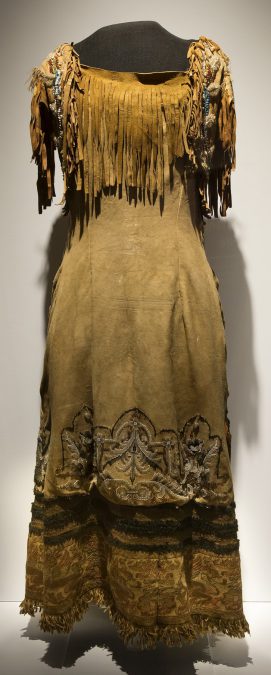
Guests finish the tour of new exhibits with a look at more recent Tribal history. They learn about how the Tribe has grown from 1971, when its bank account held just $550 and its assets included an aging mobile home used as an administration building, to becoming the economic engine and largest employer in Pottawatomie County. The final exhibit highlights the Nation’s constitutional reform and many Tribal enterprises.
Just outside the main exhibit floor is the Long Room, where visitors learn how Potawatomi have participated in wars and conflicts throughout history. The venue also serves as a memorial for many Citizen Potawatomi Nation military veterans. The Veterans Wall of Honor displays photos of Tribal members who have served in the U.S. armed forces.
“I hope that visitors leaving the center will realize the heartbreaking disappointments that the Citizen Potawatomi Nation and other tribes have experienced,” Capps said. “I especially want those visitors to see that sovereignty is the key to our tribe progressing as it has done throughout the years.
“I want them to recognize that CPN deeply cares about our heritage and culture. May they comprehend that our magnificent Cultural Heritage Center is testimony to that fact,” she added. “Dr. Kelli Mosteller has done a tremendous job to overcome the misfortune that at our center experienced in March 2014.”
A lengthy process
On March 31, 2014, the City of Shawnee turned on an uncapped water line that terminated directly under the Cultural Heritage Center Long Room. More than 30 CPN employees responded as water poured into the building for more than two hours. An estimated 100,000 gallons flooded the building, ruining exhibits and causing structural damage.
Through July 2014, every day, 10 industrial dehumidifiers pumped hundreds of gallons of moisture from the building. By August, Heritage Center staff began laying the new floor, but after a few days, it became apparent there was still too much moisture in the building. The glue liquefied and the flooring, along with the entire concrete slab below the Long Room, had to be removed.
“I was proud of the tribal employees who showed up to get the flooring up and try to push the water toward the doors, and stack sandbags to help channel the water out,” Chairman Barrett said. “The channels of water ran about a foot deep for hours. It seems like it’s been a long time, but considering all they had to overcome, it has been a mammoth undertaking.”
Additionally, a French drain was installed beneath the floor to deal with ongoing moisture issues.
Renovations of the 18,000 square-foot center finally began in 2016.
“It took a long time for us to reach an agreement with the insurance company on a settlement,” Mosteller said. “Once we had an idea of what the settlement would be, we began working on a budget and planning for new exhibits.”
Looking ahead
Citizen Potawatomi Nation hosted the Cultural Heritage Center’s community-wide grand reopening event Jan. 20. Although the museum is mostly complete, there will be ongoing changes and more exhibits for the 2018 Family Reunion Festival.
“We will watch how visitors interact with and respond to the exhibits to see if there is anything we need to change to make it more engaging or accessible,” Mosteller said.
The Bourbonnais cabin will also undergo some repairs. Heritage center staff is working with an architect who specializes in historic buildings to ensure the cabin remains structurally sound.
CPN Cultural Heritage Center
8 a.m.-5 p.m. Monday-Friday and 10 a.m.-3 p.m. Saturday
1899 S. Gordon Cooper Drive
Shawnee, Oklahoma
potawatomiheritage.com
405-878-5830
Entry is free
